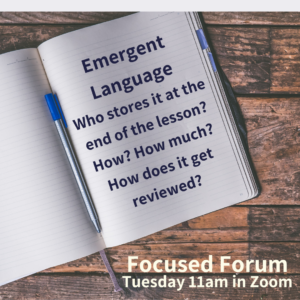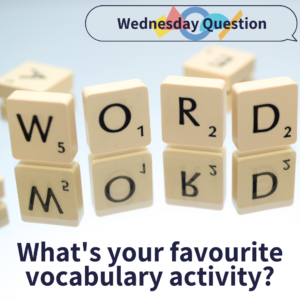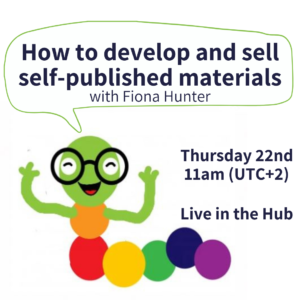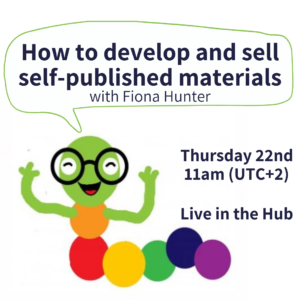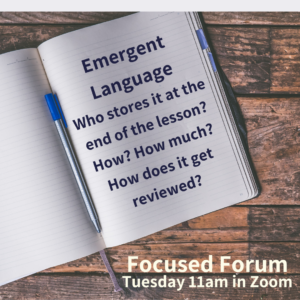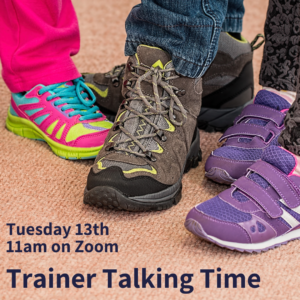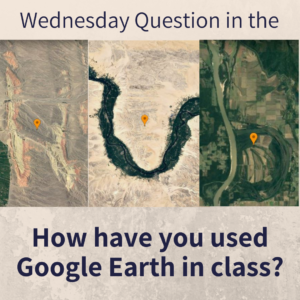… writing Sustainable Development Goals into syllabus. It’s a long, boring, time-consuming job but it does represent a shift in the profession making these things a priority.
…getting deeply involved in student registration and uncertain planning for the next academic year in September.
… trying to achieve a healthier relationship with technology. Some try to limit the times we use devices trying to keep time tech-free. Others go for a mindful use of phones. The conversation and the “battle” goes on for us all!
… trying to keep up with all the various threads of our lives, both personally and professionally. Sometimes it feels overwhelming, other times things feel in balance and in “flow”.
More on “mediation”
The conversation continues in the TEFL Development Hub of what mediation is. We’re getting closer to getting a good grip on this. It’s all about bridging the communicative gaps for students and all users of English. Mediation activities are so often communicative tasks we’ve been doing for years; information exchanges, paraphrasing, explaining situations, transferring information, etc. and we’re just adding a useful label. The reading and listening into writing activities of the Trinity ISE exams are good examples of mediation that have been going on for years; it’s nothing new and it is helpful. The term has been around at conferences for the last few years, one of the participants remembers a happy accident at an ACEIA conference when they ended up in a mediation session thinking it would be something very different! The term is useful as it values those skills specifically alongside other skills. All too often though it is imposed from above with little buy-in garnered from teachers who then have to implement mediation into lessons and exams. By way of a summary, it feels important to recognise mediation as a skill but pressure shouldn’t be put on teachers to have to teach and test it.
Additional note: The EOIs in Spain have implemented mediation across the board and often use English File as a course book. English File therefore contains all EOI material, including mediation resources.
Big up for voice recognition technology
Another recurring Hub theme, which started in Lina’s webinar on pronunciation, is that of voice recognition technology. This time we talked briefly about how useful it is for presentations, webinars, online classes, etc. and is often amazingly accurate!
We also looked at “highlighting” bubbles to highlight something from the chat on the screen.
Please add your favourite apps into the chat on the Facebook post. It’d be great to get a list together.
Top TEFL Reads
We continued the chat around one of the recent Hub questions about favourite ELT books.
The Etymologicon (Forsyth, M.) and The Story of English in 100 Words (Crystal, D.) were mentioned as go-to language reads.
We wondered whether books have, in the digi-age, become decoration more than anything else. There’s so much online (including so much rubbish too!), the idea of books feels more and more distant.
We got on a roll about all sorts of ELT books too; honourable mentions went to ETpedia Grammar (Jones, C. and Barber, D., both TEFL Development Hub members!), 500 Activities for the Primary Classroom (Read, C.), 700 Classroom Activities (Seymour, D. and Popova, M.).
Straying away from matters strictly ELT but still within education, Visible Learning, Feedback in schools (Hattie, J) John Hattie collected a huge number of studies to try to identify what really makes a difference in learning. Well worth looking into. We moved into other wider educational reading, particularly looking towards the US as being on the cutting-edge. One of the group is currently reading The best teacher in you – How to accelerate learning and change lives (Quinn, R. Heynoski, K, Thomas, M, Spreitzer, G.) We asked ourselves how aware we are of the most recent, cutting edge work and where it comes from; should we look further afield for inspiration? Yes, we should, but where?!
We talked about how hybrid learning has been going on for a long time in other contexts, often in huge countries like the US and Australia. For university work the model seems to make so much sense but then came back to our own experiences and even the biggest advocates of the possibilities around hybrid learning doubting its effectiveness in our under 10s classes. Extremely experienced young learner teachers in the group commented that hybrid teaching with YLs is challenging, it feels like we’re consistently not succeeding and while smaller class sizes help a bit the feeling in the group was that cognitively it just doesn’t work for our young learners. Hybrid teaching with YLs seems to have significantly reduced the joy in teaching, with teachers reporting less space for emergent language to develop and less spontaneity and perhaps most importantly, less engagement.
A TEFL Development Hub not-just-Books Club?
A rather lovely idea emerged from the conversation about books, research, etc. Wouldn’t it be great to have a space where we can share whatever we’ve found enriching and have a space to talk about it all together? We started with the idea of a book club, traditionally where we all read the same text and then meet to share impressions. This would be fabulous but, how would we decide what books to read? And really, would we keep up with the required reading?! So we tried a different angle…
We all loved the idea of a place to share our recent inspirations. We could include anything we’ve been inspired by recently and think others in the Hub would benefit from; we could include books, articles, blogs, vlogs, quotes, images…. Anything really! People could just share whatever they want to and to say why they have found it interesting; it could be a one-minute introduction with a question to the group, or perhaps 5 minutes to explain the main take-aways, a free format to share and circulate ideas. That sounds like a great place for the Hub to be!
The Evolution of ELT Conferences
Another recurring Hub theme here.
Some said that online conferences are so tiring with so many hours in a row in front of the screen. We talked as well about being more ‘present’ at a face-to-face conference – there are no homelife distractions, you’re very much ‘in the zone’.
We also recognised that it’s a really different experience as a speaker too without the natural reactions in the room. Can workshops still be considered workshops if you don’t get the chance to talk to other people? Although we can make use of the private chat facility to have individual conversations, if the chat box is busy, these messages can easily be missed. One participant shared that presenting on YouTube is a particularly weird experience! Presenting online can be quite isolating if you’re just talking to a screen.
There was praise for the way InnovateELT hosted their event with everything done through Zoom in a social/interactive way and BRAZ-TESOL was hosting online events pre-pandemic so some people are used to the intensity of an online conference. People also mentioned finding it easier to organise notes watching things online. TESOL-SPAIN’s use of the Whova app for their conference was also celebrated, it allowed attendees to connect in the build-up to the event as well as throughout the two weekends, the week in the middle and even afterwards too. People really enjoyed the ease of connection, for many of us it was better than a face-to-face event when we might not want to approach people, but it felt so easy through the app; lots of us made new contacts, new friends.
We talked briefly about netiquette at conferences as well – should people be encouraged to have their cameras on?
There was a recognition about different types of stress distress and eustress, the second being euphoric stress, good stress. Do we get the same “hit” when presenting online?
Perhaps the future is in hybrid events? …let’s wait and see.
Pronunciation coaches and the responsibility of FLESes
We talked a little about the perceptions of what a ‘pronunciation coach’ is and whether we feel wary of ‘marketing’ ourselves as one if we are a First-Language English Speaker (FLES). There’s a lot of native speakerism and we wouldn’t want people to think as a FLES pronunciation coach that we would be promoting accent reduction or pushing for students to produce a particular FLES model.
We also talked about some of the prejudice around what a FLES is – it doesn’t tend to include Indian English, Jamaican English, South African English, etc.
Someone also mentioned feeling disappointed that some schools which are members of established organisations use ‘native speakers’ as one of the selling points on their websites and a feeling that as a DipTESOL-qualified teacher, they would still lose out to a FLES with a 120-hr TEFL course with no teaching practice.
This is an area of our profession where there is still so much to do.
COVID around the world
We shared COVID experiences from around the world and what’s clear is that COVID is still very much with us and still very dangerous.
Argentina was heading back into a full lockdown with political points being scored all over the place to the detriment of dealing with the crisis; the President declared that schools would be going back online and then just a few days later the Mayor of Buenos Aires overturned the decision requiring students to go back to school. The member in question was herself recovering from COVID, we wish her well in her recovery.
From Germany, the feeling of uncertainty is still dominating with a member saying that nobody seems to know what to do.
Lesson planning – theory or practice?
A question was posed as to whether the lesson plan as laid out in DipTESOL/DELTA was real and appropriate or a theoretical tool which doesn’t truly represent teachers’ work in the classroom.
We agreed that Diploma-level lesson plans necessarily need to take into account far more factors than a normal lesson plan. We might cram in so many elements into a Dip-level lesson that would normally stretch over the course of several normal lessons and this is what makes it feel inauthentic and frustrating. Having said that we recognised that this approach is necessary for the one-off “official” observation towards the end of the course which requires evidence of all those angles being appropriately covered.
We talked about how our books are able to do most of the planning for us and we can just tinker with it to balance the needs for our students.
A plan is a plan, an idea about how we think a lesson might go, but so often it goes in different directions.
We wondered if we as teachers look for a lesson plan that flows from one activity to another through a discernible narrative but perhaps our students are less bothered about such things, especially those studying for exams. Timing never works out as planned and we always want to build in wiggle room to accommodate the shifts and the emergent language of the class, but “there’s no space” for that, is that because of the lesson plan? And if that’s the case, how important are lesson aims? Do we need an aim at all? If we don’t have an aim, how can we measure success and evaluate learner outcomes? We also need to know why we’re doing what we’re doing, these are effectively planning decisions which of course we can alter as we move through the class.
We talked about the aim coming from the students and how all students have their own objectives, often different from each other’s, so a teacher’s job is, in part, to navigate between these differing requirements. Some in the group enjoyed negotiating the syllabus with certain groups; look at the syllabus, what do you need? What do you want? This approach might work better for older teens and adults.
And while we’re at it, what of the student-centred approach? How many times have students felt a sense of accomplishment as they evaluate themselves at the end of a course saying “now I understand you better” which for them is amazing but probably not our aim.
We also talked about behavioural aims too, for example, “by the end of the lesson my students will better understand the need for correction and be more open to it”. This could lead to an interesting conversation about the value of errors, peer correction, etc. we talked about the value in sharing our aims with the students (we can write them on the board at the beginning of class) and encouraging understanding of learning processes. We mulled the idea of whether we are trying to impose our ideals onto the students. We all agreed the most important thing is to talk to our students appropriately.
Writing
We talked a little about co-authoring in the ELT writing community, and the need for communication, different people can have different agendas and ideas, people might not be used to working with one another and a serious relationship needs to develop. We were happy to hear that so much is built into a new book; as well as the grammar and vocal, sustainable development goals and “cultural issues” all need to be accommodated. What happens though if one writer is really passionate about inclusivity and the other is not?
We referenced the Raise Up! webinar and wondered whether we should/could suggest a Raise Up! for Kids, all present were deeply committed to inclusivity. We wondered what would happen to pronouns moving forward; will he and she change to they or maybe zie? And what should we do when people say things we consider may be offensive to students in the classroom and indeed to others beyond. Do we keep trying? We thought it depends on who is doing it and how’s it happening. And recycling some thoughts on swearing; see Nicolas Cage and Stephen Fry (separately, not together!)
Congratulations on making it to the end!
There was a lot of amazing chat and we’re trying to keep it moving around. Thanks to all and see you at the next coffee breaks!


